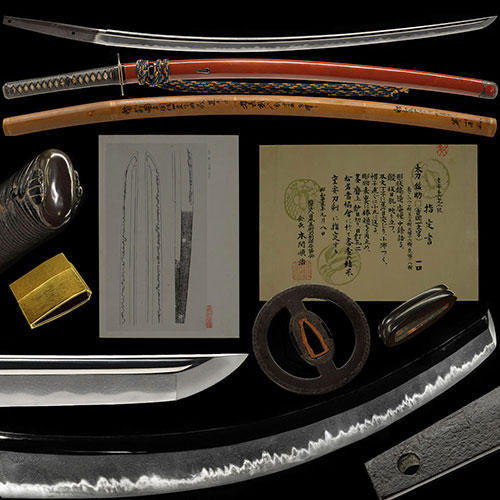
助義 刀Sukeyoshi Katana
No.925733在銘 助義 吉岡一文字 鎌倉末期元応頃 乱れ映り立ち丁子華やかに乱れ匂口明るく冴える傑作 二尺二寸五分Zaimei Sukeyoshi, Yoshioka Ichimonji Late Kamakura Genou period Midare-Utsuritachi Gorgeous Chouji Midare Nioikuchi is bright and clear A masterpiece
ご成約Sold
- 銘表Mei-Omote
- 助義助義 Sukeyoshi
- 登録証Registration
- 東京都 Tokyo 昭和26年3月31日 3/31/26(Showa)
- 時代Period
- 鎌倉時代Kamakura period
- 法量Size
-
刃長 68.1cm (ニ尺ニ寸五分) 反り 2.4cm
元幅 2.7cm 先幅 1.7cm 元重 0.66cm 鎬厚 0.77cm 先重 0.50cm 鋒長 2.9cm 茎長 18.1cm 重量 616gHachou 68.1cm (ニ尺ニ寸五分) Sori 2.4cm
Moto-Haba 2.7cm Saki-Haba 1.7cm Moto-Kasane 0.66cm Shinogi-Thikess 0.77cm Saki-Kasane 0.50cm Kissaki-Chou 2.9cm Nakago-Chou 18.1cm Weight 616g - 国Country
- 備前Bizen
- 姿Shape
- 鎬造、庵棟、身幅尋常、反り深く、腰反りつき、中鋒。Shinogidukuri, Iorimune, Standard Mihaba, Deep Sori, Koshizori-tsuki, Chu-Kissaki
- 鍛Kitae
- 板目肌つみ、杢目肌・小杢目肌交じり、地沸微塵に厚くつき、地景よく入り、乱れ映り立つ。Itamehada-tsumi, Mokumehada, Mixed Small-Mokumehada, Jinie entered fine and thick, Chikei entered well, Midare-Utsuritatsu.
- 刃文Hamon
- 丁子乱れに、袋丁子・互の目など交じり、足・葉よく入り、匂出来、小沸深くよくつき、匂口明るい。Chouji-Midare, Fukuro-chouji, mixed Gunome, There are many Ashi and You, Nioideki, Small-Nie entered deeply, Nioikuchi is bright.
- 帽子Boushi
- 直ぐに小丸、先掃きかける。Sugunikomaru,Sakihakikakeru
- 茎Nakago
- 磨上、先切、鑢目切、目釘孔二。Suriage, Sakikiri, Yasurimegiri, Mekugiana are two(2)
- ハバキHabaki
- 金着二重Double gold
- 拵Sword mounitings
- 朱漆塗鞘肥後拵 [江戸時代]
法量
長さ103.8cm 反り4.3cm
説明
鐔 鉄地海鼠透銀象嵌、 縁頭 四分一磨地。 目貫 赤銅地九曜紋二双図金色絵。Syuurushi Nurisaya Higo Koshirae (Edo era)
Length: 103.8cm
Sori:4.3cm
Tsuba: Tetsuji Namako(Iron sea cucumber) Sukashi Ginzougan
Fuchigashira: Shibuichi Migakiji
Menuki: Syakudouji Kuyoumon Nisouzu Kiniroe - 彫物Carving
- 表裏に棒樋を角止。Bouhi is attached to the front and back.
- 説明Drscription
- 鎌倉時代の備前物は、一文字と長船の両派に代表され、一文字派は以後南北長期にかけて福岡・吉岡・岩戸などの地に繁栄し、多くの良工が輩出した。この派が一文字と呼称される所以は、茎に「一」の字をきることに因るが、銘は「一」の字のみのものと、他に「一」の字の下にさらに個銘を加えるもの、また個銘だけのものもある。吉岡一文字派は、福岡一文字派に次いで助吉を初祖として鎌倉時代後期に繁栄した。一派の代表工には助光・助吉・助茂・助次・助義などがいて「助」を通字としており、作風は、乱れの中に互の目が目立ってややこづみごころとなるものである。助義は、助吉の子で、左衛門尉といい、鎌倉末期元応から南北朝初期暦応にかけての年紀作がある。この刀は、元は76cm程の太刀で、身幅尋常、反り深く、腰反りつく優美な姿で、板目肌つみ、杢目・小杢目肌交じり、地沸微塵に厚くつき、地景よく入り、乱れ映りが立つ美しい地鉄に、丁子乱れに、袋丁子・互の目など交え華やかに乱れ、足・葉よく入り、地刃ともに健全で匂口明るく冴える。九曜紋の目貫が入る朱鞘の肥後拵が付く細川家伝来と思われる名品である。Bizen-mono in the Kamakura period was represented by both the Ichimonji and Osafune schools, and the Ichimonji school prospered in Fukuoka, Yoshioka, Iwato, and other areas until the Nanbokucho period, producing many excellent craftsmen. The reason why this school is called Ichimonji is because the character "Ichi" is cut on the stem. There are some that add an inscription, and some that only have an individual inscription. The Yoshioka Ichimonji school flourished in the latter half of the Kamakura period, following the Fukuoka Ichimonji school. Sukemitsu, Sukeyoshi, Sukemo, Suketsugu, Sukeyoshi, etc. are the representative craftsmen of the school, and they use 'suke' as a common characterSukeyoshi, a son of Sukeyoshi, was called Saemonjo, and there are chronological works from the end of the Kamakura period to the early Nanbokucho period.
This sword was originally a 76cm Tachi, Standard Mihaba, Deep Sori, With a graceful figure that Koshizoritsuku, Itamehada-tsumi, Mokume, Mixed Small-Mokume-hada,Jinie entered fine and thick, Chikei entered well, Midareutsuritatsu in beautiful Jigane, Choujimidare, Fukurochouji, Mixed Gunome and gorgeous Midare, There are many Ashi and You, Jiba is Kenzen, Nioikuchi is bright and clear,It is a masterpiece that seems to have been handed down from the Hosokawa family, and comes with a red scabbard Higo Koshirae that contains the Kuyou crest Menuki.




